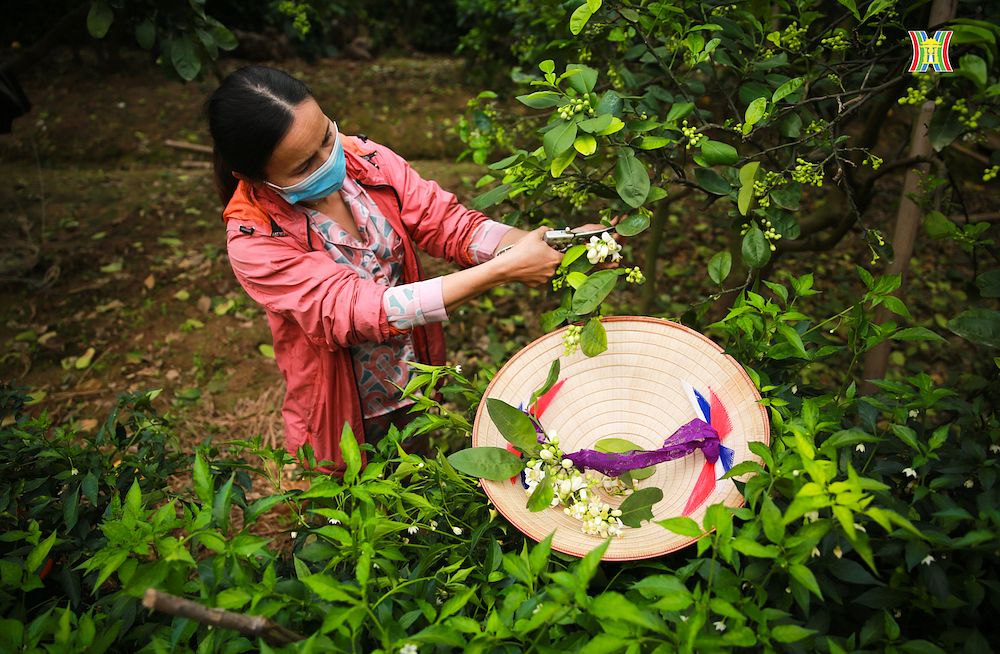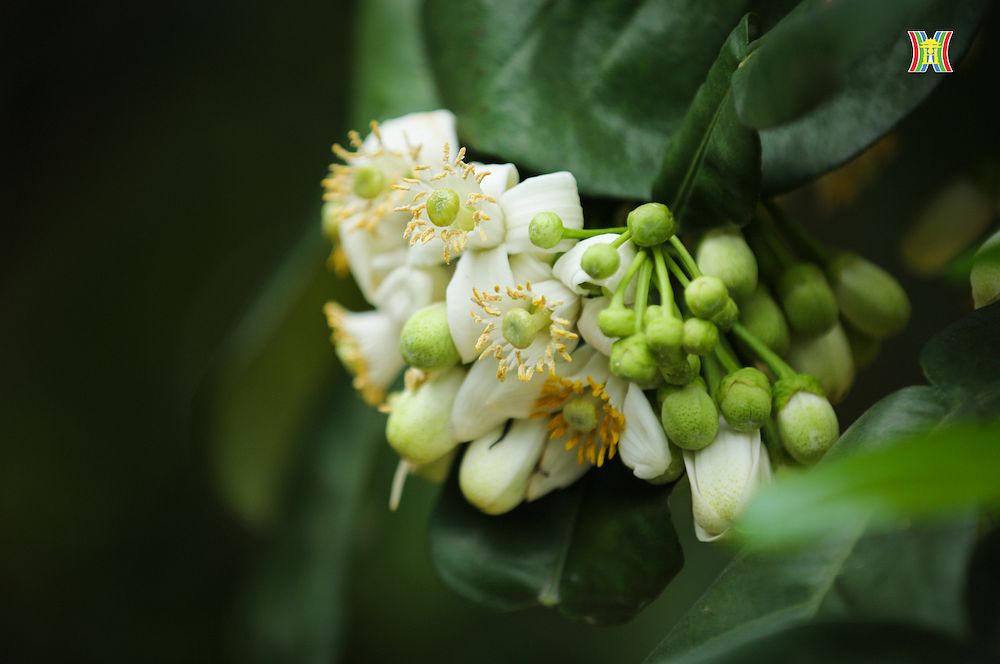Every year during this time, I can’t help but hanker for a taste of sugarcane infused with hoa bưởi, or pomelo blossom. Only hoa bưởi’s tender aroma can accentuate the flavor of this humble snack several folds.
A poetic scent
Ôi hoa đã rụng vẫn còn ngát hương / even on the ground, they never stop smelling nice.”
Reading the poem ‘Hoa bưởi’ (Pomelo Blossom) in Trần Đăng Khoa’s poetry collection Góc Sân và Khoảng Trời (The Backyard and the Sky) for the first time as a little kid, I always wondered about the smell of hoa bưởi. Could I have encountered it without knowing? My mother once told me that hoa bưởi has a “discreet smell,” one that would elude you if you try to find it, but take you by surprise when you’re not paying attention. In just a few days in March, hoa bưởi season will be upon us again.

Hoa bưởi. Photo via Thời báo Văn học Nghệ thuật.
When my dad drove me through Xã Đàn and Láng Hạ streets, it was the trays of stark white blossoms on the bicycles of street vendors that reminded me that hoa bưởi season had dawned on Hanoi.
Bưởi (Citrus grandis) is the largest member of the citrus family, native to the Tropics. According to The Food and Agriculture Organization of the United Nations, southern Thailand and northern Malaysia — home to the most cultivars of pomelos — are believed to be the origin of bưởi. Since then, the giant citrus has spread across Southeast Asia to the Mediterranean, the Americas, and Australia. In Vietnam, bưởi has its own cozy family with many endemic varieties like Đoan Hùng, Phúc Trạch, Diễn, and Năm Roi.

Pomelo cultivars in Vietnam. Image via Food and Agriculture Organization of the United Nations.
Across northern Vietnam, bưởi trees often start flowering around the third lunar month, due to the region’s four-season climate pattern. During this time, clusters of white hairless flowers emerge from the offshoots of branches. They have green sepals with short white petals at around 2–3.5cm long.
Hoa bưởi's short season lasts around one month if the climate is warm, and just 20 days if the weather is cold that year. Yet, such a fleeting period of time can leave such indelible marks on the culture of Hanoi. This time coincides with the capital’s season of drizzle and extreme humidity. It’s a transitory time of sticky condensation on your skin, but also a floral extravaganza as hoa bưởi, hoa sưa, hoa ban, hoa gạo would all start blooming, signifying the end of the coolness of spring and the impending arrival of summer.
An elegant urban decoration
Across famous nurseries in Hanoi like Minh Khai and Phú Diễn, pomelo trees burst into freckles of white blossoms. Each will be carefully handled by farmers: big, healthy clusters that are most likely to yield plump fruits will be left alone, the others are clipped during the earliest hours of the morning before they could bloom and henceforth, release all that precious scent into the air. Handfuls of hoa bưởi would go along with vendors on their rustic bikes to perfume all corners of the city.


Collecting hoa bưởi. Photo by Văn Tuyến via Đài phát thanh & Truyền hình Hà Nội.
In Hanoi, it’s easier to bump into hoa bưởi on Lê Duẩn or Giải Phóng streets — bundles of white flowers neatly arranged on a bamboo tray. On the last days of spring, it’s as if the clamorous streets of Hanoi become more graceful thanks to their presence. That infernal humid weather seems almost tolerable. Pomelo blossoms enthrall us with their aroma, inspiring a feeling of familiar comfort. No matter how busy their day can get, few Hanoians can resist stopping by for a small bundle of flowers to bring home, at around VND40,000 per 100 grams.

Hoa bưởi vendors of March. Photo by Cam Ly via Báo Lao Động.
I have a personal theory for why hoa bưởi is commonly seen only along major roads rather than the tiny thoroughfares of the Old Quarter. For one, it’s easier for Hanoians to stop by to get a lungful of floral aroma without holding up traffic too much. And secondly, despite hoa bưởi’s significant scent, in the middle of crowds and a smorgasbord of other urban smells, it won’t be able to compete; not to mention that hoa bưởi is a particularly sought-after commodity, so the vendor only needs to anchor in place and wait for potential buyers to be attracted by the scent.

Graphic by Ngọc Tạ.
The mere presence of hoa bưởi evokes in me a peculiar feeling of nostalgia. Seeing them on the street, I’m always reminded of the summers with “vertical rays of the sun,” of mom-and-pop shops encapsulating the essence of Hanoi in its local treats, of the puffs of thuốc lào that my dad smoked, and of the timid old villas whose windows stay ajar beneath the golden veil of the sun. The smell of hoa bưởi, on the other hand, brings up green garden corners where my mom washed her silky black hair; tiny bowls of scented chè; and trays of hoa bưởi sugar cane.
On loving the harbinger of time
Hoa bưởi is neither ostentatious nor complicated. It enters the daily rhythms of generations of capital inhabitants via seasonal routines and treats. The more we grow to love it, the more we feel the pull to keep it around us, perhaps in a vain attempt to prolong this fleeting moment of the year. Thus, we have traditionally devised a number of ways to distill and process the flower to retain the aroma.
The simplest way involves just putting fresh flowers in a vase, so the fragrance diffuses in our living quarters while the pretty blossoms beautify them. Barely bloomed buds are most favored for this purpose, as they carry the most perfuming potential. These buds can also be used to scent tea leaves. To make hoa bưởi tea, pickers carefully open flowers to remove the innards before putting them with tea leaves for roasting to minimize the bitter taste. In a ceramic pot, layers of tea and flowers are spread alternately, and in as soon as two days, a batch of floral tea is ready for brewing.

Hoa bưởi tea. Nguồn ảnh: An Hải Tea.
Pomelo blossom tea is often considered a treasured gift for visitors to Hanoi. The flower parts that are removed during the tea-scenting process are recycled to scent warm water for hair washing — a “beauty hack” popular amongst Vietnamese women from previous generations. Hoa bưởi is a natural cosmetic ingredient that’s believed to have the power to boost the silkiness of hair and give it a wonderful smell too.
Traditionally, Vietnamese distill the essential oil from hoa bưởi to combine with other herbal ingredients to make a remedy for colds, hangovers, stomachaches, anxiety, or just general malaise. Cooks use a few drops of the oil to give their bánh trôi, sắn dây, tào phớ, and many other dishes, a certain seasonal flair. In the essay collection Tinh hoa Hà Nội (Essences of Hanoi), writer Mai Thục explains: “Every distillation season, Hàng Than Street is enveloped in the thick fragrance of hoa bưởi. Now, we still yearn for pomelo smell sometimes, but can never distill it ourselves.”

Pomelo blossom-scented sugar cane. Photo via VnExpress.
It would be lacking to discuss the seasonal treats of this time without mentioning the magical hoa bưởi-scented sugarcane — the casual but elegant snack only for those in the know. Preparations are simple enough: sugarcanes are chopped into inch-long segments, you add a sprinkle of fresh hoa bưởi, and then chill them with ice or in the fridge for three hours. If you’re in the mood for some pizzazz, you can steam them using the water bath technique so the scent can seep deeper into the cane. On the sweltering days of March, munching on these aromatic sweet chunks is like a salve to ward off the annoyance caused by the punishing weather.
Hanoians would often display hoa bưởi from mid-season when the weather is not too humid, so the fragrance can linger longer. For altars, only branches with ample blossoms and pretty flowers are chosen. Hoa bưởi usually shows up in fruit displays of the first lunar month, as a nod to the beauty of nature, symbolizing hopes for a good year ahead. Its scent is believed to be able to dispel bad mojo and cleanse the air inside the altar room. In the fruit display, the pomelo blossom represents the “white” element in the five elements of metal, wood, water, fire, and earth.
In Vietnamese culture, at times, hoa bưởi is seen as a symbol of a pure love, perhaps because of its color and gentle aroma, making it an ideal romantic gift for the financially strapped. Hoa bưởi as a love trinket appears in ‘Hương Thầm’ (A Discreet Scent), a song that was adapted by composer Vũ Hoàng from a poem by Phan Thị Thanh Nhàn:
“Giấu một chùm hoa trong chiếc khăn tay / A blossom hidden inside a handkerchief
Cô gái ngập ngừng sang nhà hàng xóm / She reluctantly walks to the house next door
Bên ấy có người ngày mai ra trận / Somebody there is heading to war tomorrow
Bên ấy có người ngày mai đi xa / Somebody there is going away tomorrow
Nào ai đã một lần dám nói / Nobody has dared to say a thing
Hương bưởi thơm cho lòng bối rối / The pomelo flower perfumes flustered hearts
Cô gái như chùm hoa lặng lẽ / She’s like a timid blossom
Nhờ hương thơm nói hộ tình yêu / Speaking words of love through her scent.”
The days of March pass as quickly as blooming pomelo blossoms, but they still manage to leave an impression on the daily life and memories of Hanoians, so that once the flowering season has gone, we'll never stop longing for it.


















